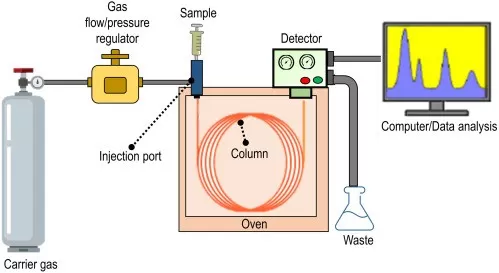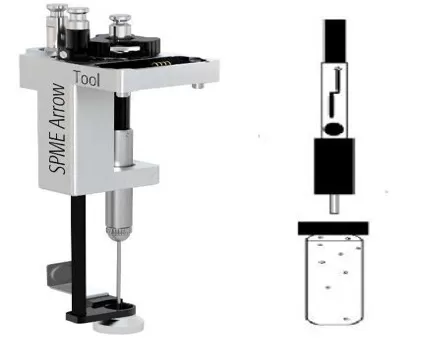Understanding GC-MS: A Powerful Analytical Tool in Modern Chemistry
In contemporary scientific research, gas chromatography-mass spectrometry (GC-MS) has become an indispensable tool in analytical chemistry. It offers a highly efficient means of separating compounds in a mixture while simultaneously providing precise identification and structural elucidation through mass spectrometry. This blog explores the fundamental principles, working processes, and advantages of GC-MS technology. Whether you are a beginner in scientific research or an expert looking to deepen your understanding, this guide will provide valuable insights into this powerful analytical technique.
What is GC-MS?
Chromatographic techniques are essential for quantitative analysis and the separation of complex mixtures. However, traditional chromatographic detectors often struggle with compound identification and overlapping peaks. Spectroscopic methods like mass spectrometry (MS) provide superior structural analysis but are limited to pure compounds due to the lack of separation techniques. By combining chromatography and spectroscopic methods, GC-MS overcomes these limitations, making it one of the most effective tools for analyzing complex samples.

Scheme of a gas chromatography
Principles of GC-MS Operation
GC-MS operates based on the separation power of gas chromatography (GC) and the identification capabilities of mass spectrometry (MS). The process follows these key steps:
1. Sample Preparation and Injection
The sample is prepared using solid-phase microextraction (SPME), a technique that integrates extraction, concentration, and desorption into one process. This method is solvent-efficient, highly sensitive, and provides excellent reproducibility. The sample is introduced into the gas chromatograph via an automatic sampler. If the sample is in liquid form, it undergoes vaporization at the injector port before being transported into the column.

Headspace Solid-Phase Microextraction Device
2. Gas Chromatography Separation
The sample is carried by an inert gas (e.g., helium) into the chromatographic column, where it interacts with the stationary phase. Different compounds travel at varying speeds through the column due to their unique interactions with the stationary phase, resulting in separation.
3. Mass Spectrometry Analysis
After separation, the compounds enter the mass spectrometer for analysis. The MS unit comprises several key components:
- Ion Source: Converts neutral molecules into charged ions. The most common ionization method is Electron Ionization (EI), which fragments molecules to produce a spectrum of ionized fragments.
- Mass Analyzer: Separates ions based on their mass-to-charge ratio (m/z). Common mass analyzers include quadrupole, time-of-flight (TOF), and ion trap analyzers. Quadrupole analyzers are widely used due to their compact design and high stability.
- Detector: Captures and quantifies ions, generating a mass spectrum that serves as a unique fingerprint for compound identification.
 Source Schematic Diagram_1742200564_WNo_850d273.webp)
Electron Ionization (EI) Source Schematic Diagram
4. Data Analysis and Compound Identification
The resulting mass spectra are compared with reference databases such as NIST, which contains extensive spectral libraries. By analyzing the fragmentation pattern, scientists can determine the molecular structure and composition of unknown compounds.
Strengths and Limitations of GC-MS
GC-MS is a powerful analytical tool with a wide range of applications, but like any technique, it has both strengths and limitations. Below, we explore some of the key advantages that make GC-MS indispensable, as well as the challenges that may arise when using this technology.
High Sensitivity and Exceptional Detection Limits
One of the greatest strengths of GC-MS is its ability to detect trace levels of compounds, often down to parts per trillion (ppt). This extreme sensitivity is crucial in forensic toxicology, environmental pollution monitoring, and pharmaceutical quality control, where even minute amounts of a substance can have significant implications.
Comprehensive Molecular Identification
Unlike conventional chromatographic detectors that rely solely on retention times, GC-MS provides detailed structural information by generating reproducible mass spectra. The ability to compare these spectra with extensive databases enhances compound identification, allowing analysts to differentiate even structurally similar compounds with high accuracy.
Efficient Separation and Analysis Speed
GC-MS is known for its high separation efficiency, enabling the analysis of complex mixtures in a short period. In industries such as petroleum and fragrance analysis, where hundreds of compounds need to be separated and identified, GC-MS provides rapid and reliable results, significantly improving workflow efficiency.
Limitations of Volatility and Thermal Stability
One of the major limitations of GC-MS is that it requires analytes to be volatile or derivatized to ensure efficient vaporization. High-polarity and high-molecular-weight compounds often require chemical modification before analysis, which can introduce additional complexity and potential sources of error.
Applications of GC-MS
GC-MS has become an indispensable tool in a wide range of fields, offering exceptional precision and sensitivity across multiple industries.
- Environmental Monitoring: Environmental scientists use GC-MS to detect pollutants such as pesticides, volatile organic compounds (VOCs), and industrial emissions. By analyzing air, water, and soil samples, GC-MS helps in assessing environmental contamination, identifying sources of pollution, and ensuring compliance with environmental regulations. The ability to measure ultra-trace levels of contaminants allows for proactive environmental management and pollution control strategies.
- Forensic Science: Law enforcement agencies and forensic scientists rely on GC-MS for toxicology screenings, drug testing, and explosive residue analysis. The technique is crucial in criminal investigations, as it provides definitive evidence in cases involving illicit drugs, arson, and poisoning. GC-MS helps determine the presence of controlled substances, identify unknown chemicals at crime scenes, and confirm exposure to hazardous substances in forensic pathology.
- Food and Beverage Industry: Food safety and quality control are enhanced by GC-MS through the identification of contaminants, preservatives, and food adulterants. The technique is widely used to detect pesticide residues in agricultural products, monitor the presence of harmful additives, and ensure regulatory compliance. GC-MS is also employed in flavor and fragrance analysis, helping manufacturers maintain product consistency and authenticity.
- Pharmaceutical Research: The pharmaceutical industry benefits from GC-MS in drug development, formulation testing, and stability studies. It plays a critical role in detecting impurities, ensuring the purity of active pharmaceutical ingredients (APIs), and analyzing metabolic pathways of drugs. By providing accurate compositional analysis, GC-MS helps pharmaceutical companies maintain high standards of drug safety and efficacy.
- Clinical and Biomedical Research: In medicine, GC-MS is used for metabolic profiling, disease biomarker identification, and pharmacokinetics studies. Researchers use the technique to analyze volatile compounds in breath, blood, and urine samples, aiding in early disease detection and therapeutic monitoring. GC-MS is also instrumental in newborn screening programs, where it helps identify metabolic disorders that require immediate medical intervention.
Reference
Tarsila Rodrigues Arruda, Bruno Ricardo de Castro Leite Junior, Clara Suprani Marques, et al., Chapter 2 - Emerging techniques for extraction and characterization of natural compounds, Editor(s): Bhanu Prakash, Jackline Freitas Brilhante de São José, Green Products in Food Safety, Academic Press, 2023, Pages 29-79, ISBN 9780323955904, https://doi.org/10.1016/B978-0-323-95590-4.00009-6.
Wilfried M. A. Niessen, Ricardo A. Correa C. Chapter 3-Fragmentation of Even-Electron Ions, Interpretation of MS-MS Mass Spectra of Drugs and Pesticides. John Wiley & Sons, 2017. ISBN: 978-1-118-50018-7, https://doi.org/10.1002/9781119294269
McNair H M, Miller J M, Snow N H. Basic gas chromatography. John Wiley & Sons, 2019. ISBN:9781119450757. https://doi.org/10.1002/9781119450795
Read more
- LC-MS VS GC-MS: What's the Difference
- LC vs. HPLC vs. UHPLC: Tracing the Evolution of Chromatographic Techniques
- Mastering Chromatography: Everything You Need to Know
- DIA Proteomics vs DDA Proteomics: A Comprehensive Comparison
- Multi-Omics Association Analysis Series
- Omics Data Processing Series
- Omics Data Analysis Series


